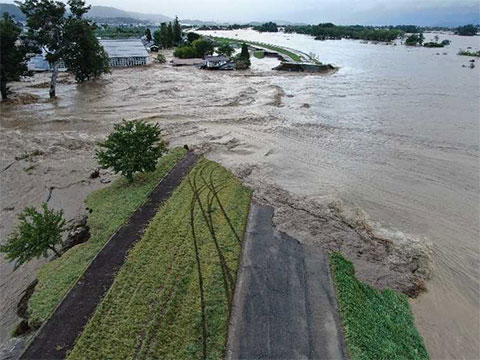News
Heavy Rain Damage Simulated through Supercomputer: Positive Results Reported at Climate Risk Symposium Updated in December 2019
On October 21, MEXT’s “Integrated Research Program for Advancing Climate Models (TOUGOU)” held a public symposium titled “Preparing for Global Warming-Necessary Forecasts and Risks to Expect” at Hitotsubashi Auditorium in Chiyoda-ku, Tokyo. Researchers in meteorology introduced latest results such as simulations of heavy rain and flooding caused by large typhoons like Hagibis which hit Japan on October 13. Hagibis caused massive prolonged damage across the nation.
MEXT’s “Integrated Climate Model Advancement Research Program” develops a supercomputer calculation model that can predict the Earth's climate around the end of this century and can compare simulation results and actual climate in various regions. This is a cross-sectional research project that predicts natural disasters that may occur, and aims at “Improving Formulas Used in Climate Simulations.”
At the symposium, Deputy Director of the National Institute for Environmental Studies, Center for Climate Change Adaptation (NIES-CCCA), Dr. Yasuaki Hijioka emphasized the importance for more detailed data: “If the forecast data resolution is 250 meters, damage is estimated to be 26.3 billion yen. That is way less than the damage calculated from a 1-kiometer resolution (40.9 billion yen).” He stated that this gap will be even larger compared to differences between each climate model.” He also asked what would the most appropriate resolution range for local governments to take countermeasures.
Assoc. Prof. Tetsuya Takemi of Kyoto University Disaster Prevention Research Institute (DPRI) said, “Should a mega-typhoon like 1959 Typhoon Vera hit Japan during variable warm climate caused by global warming, its center pressure would reach 10 hectopascals and the typhoon’s wind speed would increase 7-8 meters.” “Global warming definitely increases risks for disaster,” he added. For the recent Typhoon Hagibis, "Large amounts of water vapor flowed into the sky, and it was very wet in wide areas. This caused heavy rain similar to the intense precipitation of east Japan during July 2018. Such inflows of vapor won’t be rare in the future," Prof. Takemi warned.
Prof. Kei Yoshimura (Institute of Industrial Science at the University of Tokyo), said that he is developing a model that predicts river flooding after heavy rain. It was reported that the flooding due to Kinugawa’s heavy rain in 2015 was predicted with a probability of 70%, 39 hours prior to the flooding, and 100% accuracy 15 hours before the flooding. Regarding Hagibis, “Although it is still under analysis, our model predicted the October 13 flooding of Chikuma River as of October 11 morning (approx. 2 days before). We also predicted the flooding of the Tama River, upstream Arakawa River, Watarase River, and Kinu River,” commented Prof. Yoshimura.
In June 2018, the government enacted the “Climate Change Adaptation Law” aimed at reducing crop damage and weather disasters associated with global warming. It was the first law of this kind in the world to actively work on adaptive measures in order to cope with climate change as well as mitigation measures to suppress artificial warming. In recent years, the extreme climate beyond expectation are on the rise. It has become increasingly important to know the scale of damage in advance through research using supercomputers and to take optimal measures.








